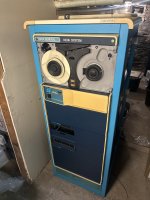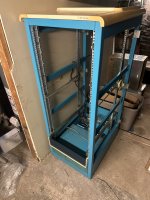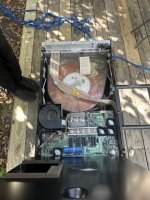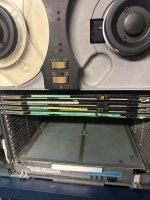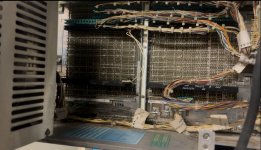cullyrichard
Experienced Member
Hi All,
I am primarily a DEC PDP-11 guy and I have done some work on PDP-8 machines more recently, but I could not say no when a complete NOVA 4/X system came up for sale. The plan is to get this machine running as a counterpart to my existing PDP11 systems and to archive and explore whatever software and files are on the hard drive that was included.
The machine is configured with a 6100 hard disk / diskette drive and a 6125 tape drive.
The Nova 4/X chassis itself is equipped as follows:
T 005 3552 R11 (dasher controller)
T 005 9973 R09 Unknown, board contains several COM2017 or equivalent UART chips
T 005-13734 R06 DISK CONTROLLER
T 005 15289 R10 TAPE CONTROLLER
T 005 12136 R06 (128K BYTE (64K WORD) RAM BOARD)
T 005 12373 R10 (FLOATING POINT UNIT)
T 005 12067 R23 (NOVA 4/X CPU W/ MULTIPLY / DIVIDE)
T 005 12061 R54 (POWER SUPPLY W/O BATTERY BACKUP)
It was built at the DG Westbrook, Maine plant, and was system #98. I am not sure what quantity these integrated systems were built or the overall total, but the construction gives the impression that there were not an abundance of these 5' tall machines out there.
I'm working on some reforming of the large caps mounted in the rear of the NOVA 4's chassis before I apply power. These caps are nice sprague caps and they are not leaking any electrolyte so I am reasonably confident they will reform. I usually just apply power but the caps are the size of soda cans and I would prefer for them to not detonate in my basement. there are even larger caps in the hard drive that will need repair.
I'm curious if anyone has any thoughts or knowledge to share on this machine. I have been in contact with Bruce at novas are forever and I've been scraping the internet for every related manual I can find. I'm excited to get this project under way and revive a NOVA to share with the world. I also plan to release a video series documenting the progress
I am primarily a DEC PDP-11 guy and I have done some work on PDP-8 machines more recently, but I could not say no when a complete NOVA 4/X system came up for sale. The plan is to get this machine running as a counterpart to my existing PDP11 systems and to archive and explore whatever software and files are on the hard drive that was included.
The machine is configured with a 6100 hard disk / diskette drive and a 6125 tape drive.
The Nova 4/X chassis itself is equipped as follows:
T 005 3552 R11 (dasher controller)
T 005 9973 R09 Unknown, board contains several COM2017 or equivalent UART chips
T 005-13734 R06 DISK CONTROLLER
T 005 15289 R10 TAPE CONTROLLER
T 005 12136 R06 (128K BYTE (64K WORD) RAM BOARD)
T 005 12373 R10 (FLOATING POINT UNIT)
T 005 12067 R23 (NOVA 4/X CPU W/ MULTIPLY / DIVIDE)
T 005 12061 R54 (POWER SUPPLY W/O BATTERY BACKUP)
It was built at the DG Westbrook, Maine plant, and was system #98. I am not sure what quantity these integrated systems were built or the overall total, but the construction gives the impression that there were not an abundance of these 5' tall machines out there.
I'm working on some reforming of the large caps mounted in the rear of the NOVA 4's chassis before I apply power. These caps are nice sprague caps and they are not leaking any electrolyte so I am reasonably confident they will reform. I usually just apply power but the caps are the size of soda cans and I would prefer for them to not detonate in my basement. there are even larger caps in the hard drive that will need repair.
I'm curious if anyone has any thoughts or knowledge to share on this machine. I have been in contact with Bruce at novas are forever and I've been scraping the internet for every related manual I can find. I'm excited to get this project under way and revive a NOVA to share with the world. I also plan to release a video series documenting the progress

